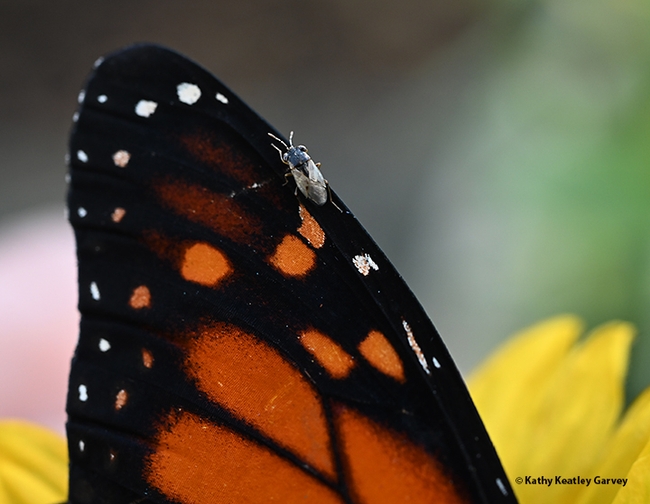You've heard folks call insects "big 'ol bugs" (often in astonishment or terror), right?
But have you ever seen a "bigeyed bug on a monarch butterfly?"
Bigeyed bugs, Geocoris spp., are beneficial insects, "found mostly on low-growing plants, including many field and row crops and in gardens," according to the UC Statewide Integrated Management Program (UC IPM). "Adults and nymphs feed by sucking prey's body contents through their needlelike mouthparts. Bigeyed bugs feed on bug nymphs, flea beetles, insect eggs, small caterpillars, and all stages of aphids, mites, and whiteflies. Bigeyed bugs also feed harmlessly on pollen, seeds, and plant juices and are not plant pests."
And Wikipedia tells us: "Big-eyed bugs, like other true bugs, have piercing-sucking mouthparts and feed by stabbing their prey and sucking or lapping the juices. Although their effectiveness as predators is not well understood, studies have shown that nymphs can eat as many as 1600 spider mites before reaching adulthood, while adults have been reported consuming as many as 80 mites per day."
So, it's Jan. 4, 2024, and here's this bigeyed bug resting in a patch of blanket flowers (Gaillardia) in our Vacaville pollinator garden. Then it's briefly crawling up the wing of a monarch that's nectaring on the flowers. (Yes, fall and winter monarch breeding does occur here in central California, according to butterfly guru Art Shapiro, UC Davis distinguished professor emeritus. He recorded a monarch in flight on Jan. 19, 2020 in Sacramento, but even earlier than that--UC Davis professor Louie Yang of the Department of Entomology and Nematology spotted a monarch flying Jan. 8, 2012 in east Davis. We saw a monarch in flight on Dec. 16, 2023 in Vacaville.)
So, what happened to the bigeyed bug and the monarch butterfly? They vanished. Both of them.
Wings up?
Attached Images:
